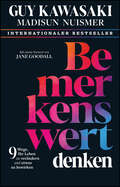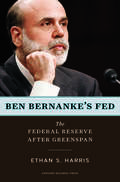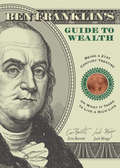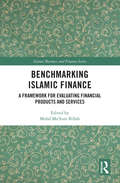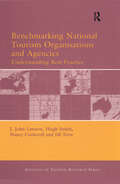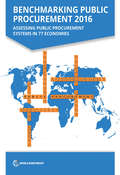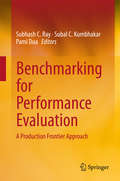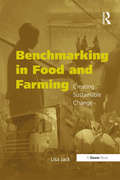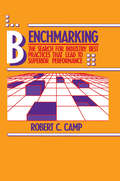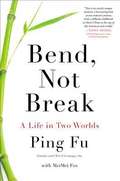- Table View
- List View
Bemerkenswert denken: 9 Wege, Ihr Leben zu verändern und etwas zu bewirken
by Guy Kawasaki Madisun NuismerBen & Jerry's Homemade Ice Cream, Inc.: A Period of Transition
by David J. Collis Melinda B. ConradBob Holland takes over as CEO of this iconoclastic ice cream company in February 1995 when it faces a major crisis. Holland must now develop a strategy that both adapts to the external environment and is consistent with the company's unique heritage.
Ben & Jerry's Homemade Ice Cream, Inc.: Keeping the Mission(s) Alive
by John TherouxBen & Jerry's is an anti-establishment, values-driven company that has become a successful venture. The dominant founder, Ben Cohen, is not an effective manager, but he brings creative marketing and product skills that have been important to the company's success. He also is controlling shareholder and the force behind the company's socially-minded culture. One of the many policies that have reflected Ben's values but which has created difficulty in managing the organization is the 5 to 1 compensation differential between the top and the bottom of the organization. Up to mid 1990, the company was operating in an explosive growth business with relatively weak competitors; this has changed by the time of the case in September 1990. The case opens as Chuck Lacy is taking over as president. He needs to decide what to do about the 5 to 1 rule and the related issues of Ben's role, and the value of the company's counterculture style. Students must consider the difficulty and importance of the general manager's responsibility in reconciling company values with commercial imperatives and to consider the effect of compensation policy on morale and organizational effectiveness.
Ben & Jerry's Homemade Ice Cream, Inc.: Keeping the Mission(s) Alive
by John TherouxBen & Jerry's is an anti-establishment, values-driven company that has become a successful venture. The dominant founder, Ben Cohen, is not an effective manager, but he brings creative marketing and product skills that have been important to the company's success. He also is controlling shareholder and the force behind the company's socially-minded culture. One of the many policies that have reflected Ben's values but which has created difficulty in managing the organization is the 5 to 1 compensation differential between the top and the bottom of the organization. Up to mid 1990, the company was operating in an explosive growth business with relatively weak competitors; this has changed by the time of the case in September 1990. The case opens as Chuck Lacy is taking over as president. He needs to decide what to do about the 5 to 1 rule and the related issues of Ben's role, and the value of the company's counterculture style. Students must consider the difficulty and importance of the general manager's responsibility in reconciling company values with commercial imperatives and to consider the effect of compensation policy on morale and organizational effectiveness.
Ben & Jerry's: How Two Real Guys Built a Business with a Social Conscience and a Sense of Humor
by Fred LagerThe former CEO of Ben & Jerry's tells how two '60s holdovers built a single ice cream store into one of America's hottest companies. "Deftly and compassionately captures [Ben's] genius in all its entrepreneurial splendor...This tale will keep you entertained."--New York Times Book Review.
Ben & Jerry's: How Two Real Guys Built a Business with a Social Conscience and a Sense of Humor
by Fred LagerThe former CEO of Ben & Jerry's tells how two '60s holdovers built a single ice cream store into one of America's hottest companies. "Deftly and compassionately captures [Ben's] genius in all its entrepreneurial splendor...This tale will keep you entertained."--New York Times Book Review.From the Trade Paperback edition.
Ben & Jerry's: Preserving Mission & Brand Within Unilever
by James E. Austin James QuinnIn the months after Ben & Jerry's was acquired by Unilever, Ben & Jerry's head social mission faces challenges and opportunities unique in the company's history, including: how to manage employee morale; whether to include synthetic ingredients to meet consumer preferences; how to preserve the company's tradition of speaking out on public issues; and how to maintain the company's distinctive brand image. Also, depicts an innovative corporate governance model with an external board comprising former Ben & Jerry's executives to advise the new CEO on managing the company's distinctive brand and values.
Ben Bernanke's Fed
by Ethan S. HarrisBen Bernanke's swearing in as Federal Reserve chairman in 2006 marked the end of Alan Greenspan's long, legendary career. To date, the new chair has garnered mixed reviews. Business economists see him as the best-qualified successor to Greenspan, while many traders and investors worry that he's too academic for the job. Meanwhile, many ordinary Americans do not even know who he is.How will Bernanke's leadership affect the Fed's actions in the coming years? How will Bernanke build on Greenspan's success, but also put his own stamp on the Fed? What will all this imply for businesses and investors? In Ben Bernanke's Fed, Ethan Harris provides exceptional insights into these crucial issues.As a leading "Fed watch" economist, Harris draws on Bernanke's academic research, his speeches as a governor of the Fed, and his first two years on the job to shed light on:· How the Federal Reserve analyzes and manages the economy using a synthesis of classical and Keynesian theory· Bernanke's strategies for fighting inflation· The implications of the new chair's remarkably plain-spoken style· How Bernanke has cultivated diverse viewpoints but still builds consensus within the FedEngaging and discerning, this book demystifies the man who has stepped into what many describe as the second most powerful job in America.
Ben Fletcher: The Life and Times of a Black Wobbly (Labor Classics Ser.)
by Peter ColeIn the early twentieth century, when many US unions disgracefully excluded black and Asian workers, the Industrial Workers of the World (IWW) warmly welcomed people of color, in keeping with their emphasis on class solidarity and their bold motto: "An Injury to One Is an Injury to All!" Ben Fletcher: The Life and Times of a Black Wobbly tells the story of one of the greatest heroes of the American working class. A brilliant union organizer and a humorous orator, Benjamin Fletcher (1890–1949) was a tremendously important and well-loved African American member of the IWW during its heyday. Fletcher helped found and lead Local 8 of the IWW's Marine Transport Workers Industrial Union, unquestionably the most powerful interracial union of its era, taking a principled stand against all forms of xenophobia and exclusion. For years, acclaimed historian Peter Cole has carefully researched the life of Ben Fletcher, painstakingly uncovering a stunning range of documents related to this extraordinary man. It includes a detailed biographical sketch of his life and history, reminiscences by fellow workers who knew him, a chronicle of the IWW's impressive decade-long run on the Philadelphia waterfront in which Fletcher played a pivotal role, and nearly all of his known writings and speeches, thus giving Fletcher's timeless voice another opportunity to inspire a new generation of workers, organizers, and agitators. This revised and expanded second edition includes new materials such as facsimile reprints of two extremely rare pamphlets on racism from the early twentieth century, more information on his prison years and personal life, additional recollections from friends, greater consideration of Fletcher from a global perspective, and much more.
Ben Franklin's Guide to Wealth: Being a 21st Century Treatise on What It Takes to Live a Thrifty Life
by Jack Mingo Erin BarrettBen Franklin's Guide to Wealth is the modern version of the treatise The Way of Wealth by Richard Saunders, one of Ben Franklin's many pseudonyms. Franklin practiced what he preached in the treatise, and it made him rich enough to have a full life, travel extensively, and follow his intellectual musings, which in turn led him to become an accomplished scientist, inventor, political activist, diplomat, and writer. Franklin wasn't born rich. He built his legacy using his intelligence, curiosity, natural good sense, and proclivity for thrift and hard work. When he died, he left a fortune. Barrett and Mingo bring practicing what Franklin preached up to date for today's busy lifestyles. It's time to get back to financial basics. It's time to think about what "rich" really means. It might mean not hiring someone to do lawn work, saving some money, and sharing time spent together as a family. It's time to look for guidance from America's original financial guru, Ben Franklin. Ben Franklin's Guide to Wealthshows readers how to apply Franklin's financial wisdom to their own lives. Quotes from the original treatise such as "If you have something to do tomorrow, do it today" and "Leisure is time for doing something useful," are followed by the authors' down-to-earth commentary. Barrett and Mingo-history and trivia buffs-offer their own sage advice on a range of financial basics, including debt, thrift, the value of work and business, developing financial responsibility, money and time, and preparing for the future. As the authors attest in the Introduction, we should listen to the way of Ben Franklin because "it works. " A clever, wise, and fun book, the financial advice in Ben Franklin's Guide to Wealth works as well today as it did 250 years ago.
Ben Graham Was a Quant
by Steven P. GreinerInnovative insights on creating models that will help you become a disciplined intelligent investorThe pioneer of value investing, Benjamin Graham, believed in a philosophy that continues to be followed by some of today's most successful investors, such as Warren Buffett. Part of this philosophy includes adhering to your stock selection process come "hell or high water" which, in his view, was one of the most important aspects of investing.So, if a quant designs and implements mathematical models for predicting stock or market movements, what better way to remain objective, then to invest using algorithms or the quantitative method? This is exactly what Ben Graham Was a Quant will show you how to do. Opening with a brief history of quantitative investing, this book quickly moves on to focus on the fundamental and financial factors used in selecting "Graham" stocks, demonstrate how to test these factors, and discuss how to combine them into a quantitative model.Reveals how to create custom screens based on Ben Graham's methods for security selectionAddresses what it takes to find those factors most influential in forecasting stock returnsExplores how to design models based on other styles and international strategiesIf you want to become a better investor, you need solid insights and the proper guidance. With Ben Graham Was a Quant, you'll receive this and much more, as you learn how to create quantitative models that follow in the footsteps of Graham's value philosophy.
Benchmarking Collaborative Networks: A Key to SME Competitiveness (Contributions to Management Science)
by Katarzyna RostekLimited potential of financial, organizational, human and technology resources doesn't provide SMEs sufficient opportunities to access information and knowledge necessary in competition. Observing the methods and tools used by large companies, this book studies the conditions under which it would be possible to provide support to SMEs at a lower cost and with greater methodological and organizational backing. The author presents the proposed solution, Benchmarking Collaborative Network, which would provide SMEs access to information about their level of competitiveness, the key areas for the creation of competitive advantage and the activities required to achieve this advantage.
Benchmarking Economic Efficiency: Technical and Allocative Fundamentals (International Series in Operations Research & Management Science #315)
by Juan Aparicio Jesús T. Pastor José L. ZofíoThis book unifies and extends the definition and measurement of economic efficiency and its use as a real-life benchmarking technique for actual organizations. Analytically, the book relies on the economic theory of duality as guiding framework. Empirically, it shows how the alternative models can be implemented by way of Data Envelopment Analysis. An accompanying software programmed in the open-source Julia language is used to solve the models. The package is a self-contained set of functions that can be used for individual learning and instruction. The source code, associated documentation, and replication notebooks are available online. The book discusses the concept of economic efficiency at the firm level, comparing observed to optimal economic performance, and its decomposition according to technical and allocative criteria. Depending on the underlying technical efficiency measure, economic efficiency can be decomposed multiplicatively or additively. Part I of the book deals with the classic multiplicative approach that decomposes cost and revenue efficiency based on radial distance functions. Subsequently, the book examines how these partial approaches can be expanded to the notion of profitability efficiency, considering both the input and output dimensions of the firm, and relying on the generalized distance function for the measurement of technical efficiency. Part II is devoted to the recent additive framework related to the decomposition of economic inefficiency defined in terms of cost, revenue, and profit. The book presents economic models for the Russell and enhanced graph Russell measures, the weighted additive distance function, the directional distance function, the modified directional distance function, and the Hölder distance function. Each model is presented in a separate chapter. New approaches that qualify and generalize previous results are also introduced in the last chapters, including the reverse directional distance function and the general direct approach. The book concludes by highlighting the importance of benchmarking economic efficiency for all business stakeholders and recalling the main conclusions obtained from many years of research on this topic. The book offers different alternatives to measure economic efficiency based on a set of desirable properties and advises on the choice of specific economic efficiency models.
Benchmarking Islamic Finance: A Framework for Evaluating Financial Products and Services (Islamic Business and Finance Series)
by Mohd Ma’Sum BillahPricing or benchmarking is a process of evaluating the performance of a financial company’s products and services or systems, against other businesses, considered to be at the top of their field, by applying a measurement of “best in performance.” This book includes contributions from the leading global experts in the field who tackle topics such as whether the Islamic financial system has been dependent on the LIBOR / EURIBOR in its benchmarking exercises to date, and thus, whether it will be affected negatively by the predicted non-existence of the LIBOR / EURIBOR from 2021 onwards. They also address the question of whether the Islamic financial system requires benchmarking of its products and services and consider the emergence of Sharī ͑ah-justified benchmarking in today’s Islamic financial system. Additionally, they look at how benchmarking formulas should be adapted to ensure the satisfaction of customers within the principles of Maqasid al-Sharī ͑ah. It takes a legal and institutional approach to the subject, which readers will find particularly valuable, as there are various forms of Islamic finance institutions that do not conform to established models in the finance industry. Furthermore, there are emerging business models that will benefit from this line of investigation. This book offers a timely analysis of these issues and redresses the existing misconceptions and misinterpretations pertaining to benchmarking, in an Islamic finance context, and, as such, provides guidance and strategies for future directions. It will appeal to researchers of Islamic banking, finance, and insurance, as well as, practitioners, particularly standard setting bodies, regulators, and policy makers.
Benchmarking National Tourism Organisations and Agencies (Advances In Tourism Research Ser.)
by Hugh Smith J. John Lennon Nancy Cockerell Jill TrewThis book examines comparative performance and best practice in National Tourism Organisations/ Administrations from extensive research carried out in 2003 and 2004. It compares qualitative and quantitative data in order to ascertain best performance. Analysis is contained in detail for eight National Tourism Organisations based in four Continents, comprising: Australia, Canada, France, Ireland, The Netherlands, South Africa and Spain. Each country is examined and analysed in the following key areas: Travel and Tourism Performance, Organisation of Tourism, The National Tourism Organisation, structure, Role, Staffing and Offices, Resources and Funding as well as providing case studies of good practice. The book includes methodology of the research and provides discussion and comment of the main roles and success formula in comparable National Tourism Organisations.• Useful, practical guide to government's involvement in tourism over the past decade or more• Brings insight from both the academic and practitioner markets• International Case Studies
Benchmarking Public Procurement 2016
by World Bank GroupPublic procurement accounts for around one-fifth of global gross domestic product (GDP). Given its size the public procurement market can improve public sector performance, promote national competitiveness, drive domestic economic growth, and boost economic development. Launched at the request of the G20 Anti-Corruption Working Group, Benchmarking Public Procurement presents actionable indicators to help countries identify and monitor policies and regulations that impact how private sector companies do business with the government in 77 economies. The Benchmarking Public Procurement 2016 report is organized under two parts: the public procurement life cycle and the complaint and reporting mechanisms indicators. Data was gathered using standardized questionnaires distributed to expert contributors in each economy. The project builds on the Doing Business methodology and aims to promote evidence-based decision making by governments and shed light over areas where few empirical data have been presented so far.
Benchmarking Transaction and Analytical Processing Systems: The Creation of a Mixed Workload Benchmark and its Application (In-Memory Data Management Research)
by Anja BogSystems for Online Transaction Processing (OLTP) and Online Analytical Processing (OLAP) are currently separate. The potential of the latest technologies and changes in operational and analytical applications over the last decade have given rise to the unification of these systems, which can be of benefit for both workloads. Research and industry have reacted and prototypes of hybrid database systems are now appearing. Benchmarks are the standard method for evaluating, comparing and supporting the development of new database systems. Because of the separation of OLTP and OLAP systems, existing benchmarks are only focused on one or the other. With the rise of hybrid database systems, benchmarks to assess these systems will be needed as well. Based on the examination of existing benchmarks, a new benchmark for hybrid database systems is introduced in this book. It is furthermore used to determine the effect of adding OLAP to an OLTP workload and is applied to analyze the impact of typically used optimizations in the historically separate OLTP and OLAP domains in mixed-workload scenarios.
Benchmarking for Best Practice
by Mohamed ZairiBenchmarking for Best Practice uses up-to-the-minute case-studies of individual companies and industry-wide quality schemes to show how and why implementation has succeeded. For any practitioner wanting to establish best practice in a wide variety of business areas, this book makes essential reading. It is also an ideal textbook on the applications of TQM since it describes concepts, covers definitions and illustrates the applications with first-hand examples.Professor Mohamed Zairi is an international expert and leading figure in the field of benchmarking. His pioneering work in this area led to the implementation of sixty comprehensive benchmarking projects in companies worldwide. He has written several books on this subject including 'Practical Benchmarking' in 1992.
Benchmarking for Performance Evaluation: A Production Frontier Approach
by Subal C. Kumbhakar Subhash C. Ray Pami DuaThis book provides a detailed introduction to the theoretical and methodological foundations of production efficiency analysis using benchmarking. Two of the more popular methods of efficiency evaluation are Stochastic Frontier Analysis (SFA) and Data Envelopment Analysis (DEA), both of which are based on the concept of a production possibility set and its frontier. Depending on the assumed objectives of the decision-making unit, a Production, Cost, or Profit Frontier is constructed from observed data on input and output quantities and prices. While SFA uses different maximum likelihood estimation techniques to estimate a parametric frontier, DEA relies on mathematical programming to create a nonparametric frontier. Yet another alternative is the Convex Nonparametric Frontier, which is based on the assumed convexity of the production possibility set and creates a piecewise linear frontier consisting of a number of tangent hyper planes. Three of the papers in this volume provide a detailed and relatively easy to follow exposition of the underlying theory from neoclassical production economics and offer step-by-step instructions on the appropriate model to apply in different contexts and how to implement them. Of particular appeal are the instructions on (i) how to write the codes for different SFA models on STATA, (ii) how to write a VBA Macro for repetitive solution of the DEA problem for each production unit on Excel Solver, and (iii) how to write the codes for the Nonparametric Convex Frontier estimation. The three other papers in the volume are primarily theoretical and will be of interest to PhD students and researchers hoping to make methodological and conceptual contributions to the field of nonparametric efficiency analysis.
Benchmarking im Krankenhaus: Controlling auf der Basis von InEK-Kostendaten (Controlling im Krankenhaus)
by Winfried Zapp Sarah Hesse Johanna Leve Peter GoerdelerDas Benchmarking stellt ein wichtiges Controlling-Instrument von Planungs- und Kontrollprozessen in Unternehmungen dar. Es ermöglicht einen systematischen quantitativen und qualitativen Vergleich gleichartiger Unternehmungen. Mithilfe des Einsatzes dieses Instrumentes können Unternehmungen ihre Marktposition im Wettbewerbsumfeld einschätzen sowie Verbesserungspotenziale identifizieren und ausschöpfen. Im Krankenhausbereich ist es sinnvoll, im Rahmen einer Benchmarking-Analyse die InEK-Kostendaten als Vergleichsgröße zu verwenden. Sie haben eine hohe Aussagekraft, da sie die Erlöse eines Krankenhauses darstellen. Die Autoren führen daher ein Benchmarking auf Basis der InEK-Kostendaten auf DRG-Ebene am Beispiel eines Modellkrankenhauses durch und leiten daraus Implementationsmöglichkeiten für die Praxis ab. Grundlage bildet eine zuvor entwickelte anwendungsorientierte Vorgehensweise.
Benchmarking in Food and Farming: Creating Sustainable Change (Gower Sustainable Food Chains Series)
by Lisa JackAt a time when food producers have to make significant changes to their businesses in order to survive, a review of benchmarking in agriculture and discussion of its future potential is critical. This book meets that need by providing an overview of existing benchmarking practices in agriculture and the food supply chain, and evaluating the potential of these practices to drive sustainable innovation in food and farming. Increasing pressures from commodity markets, corporate buyers, government and rising input prices (particularly fuel prices) are creating an environment in which farmers and their advisors are keen to make greater use of performance information for survival and growth. Where farmers are diversifying into alternative production methods, non-agricultural enterprises and on-farm production and sales, the greater the interest in a wider range of accounting tools for decision making. Lisa Jack and her contributors draw on a wide range of data and sources from Australia, New Zealand, the USA, the UK and Europe to provide critical evaluations of what might be considered 'state of the art' benchmarking practices at this time, including recent strategic developments such as the use of non-financial measures in balanced scorecards. The food and farming industry is unusual in that benchmarking takes place among large numbers of small, family-owned businesses working in a global industry. Not only, therefore, is this book important for those working in food supply chain businesses, but also for those involved in the general practice of benchmarking.
Benchmarking: The Search for Industry Best Practices that Lead to Superior Performance
by Robert C. CampWritten by Dr. Robert Camp, universally regarded as the founding father of the benchmark process, this bestseller is quite simply the definitive reference on the topic. Camp guides readers through the historic ten-step benchmarking process that he developed while at Xerox. This process is credited with reviving that company when it was floundering in 1979. Camp presents other examples of the process, including its dramatic application to L.L. Bean. He uses these examples to show managers how to relate benchmarking to their own circumstances and then provides them with expert strategy and tips so that they can efficiently and easily launch their own quest for best performance.
Benchmarks in Hospitality and Tourism
by Sungsoo PyoHow much money is your business wasting? How good is the service you deliver?This pioneering book will familiarize you with benchmarking techniques that can be used to gauge and improve the performance of hospitality and tourism businesses anywhere! With compelling case studies drawn from hotel management, environmental systems, and desti
Bend the Rules: Problem-Solving Strategies for Quiet Leaders
by Joseph L. Badaracco Jr.This chapter looks at how quiet leaders often respond to ambiguous situations by imaginatively and creatively trying to bend the rules without breaking them.
Bend, Not Break
by Ping Fu“Bamboo is flexible, bending with the wind but never breaking, capable of adapting to any circumstance. It suggests resilience, meaning that we have the ability to bounce back even from the most difficult times. . . . Your ability to thrive depends, in the end, on your attitude to your life circumstances. Take everything in stride with grace, putting forth energy when it is needed, yet always staying calm inwardly. ” —Ping Fu’s “Shanghai Papa” Ping Fu knows what it’s like to be a child soldier, a factory worker, and a political prisoner. To be beaten and raped for the crime of being born into a well-educated family. To be deported with barely enough money for a plane ticket to a bewildering new land. To start all over, without family or friends, as a maid, waitress, and student. Ping Fu also knows what it’s like to be a pioneering software programmer, an innovator, a CEO, and Inc. magazine’s Entrepreneur of the Year. To be a friend and mentor to some of the best-known names in technology. To build some of the coolest new products in the world. To give speeches that inspire huge crowds. To meet and advise the president of the United States. It sounds too unbelievable for fiction, but this is the true story of a life in two worlds. Born on the eve of China’s Cultural Revolution, Ping was separated from her family at the age of eight. She grew up fighting hunger and humiliation and shielding her younger sister from the teenagers in Mao’s Red Guard. At twenty-five, she found her way to the United States; her only resources were $80 in traveler’s checks and three phrases of English: thank you, hello, and help. Yet Ping persevered, and the hard-won lessons of her childhood guided her to success in her new homeland. Aided by her well-honed survival instincts, a few good friends, and the kindness of strangers, she grew into someone she never thought she’d be—a strong, independent, entrepreneurial leader. A love of problem solving led her to computer science, and Ping became part of the team that created NCSA Mosaic, which became Netscape, the Web browser that forever changed how we access information. She then started a company, Geomagic, that has literally reshaped the world, from personalizing prosthetic limbs to repairing NASA spaceships. Bend, Not Break depicts a journey from imprisonment to freedom, and from the dogmatic anticapitalism of Mao’s China to the high-stakes, take-no-prisoners world of technology start-ups in the United States. It is a tribute to one woman’s courage in the face of cruelty and a valuable lesson on the enduring power of resilience. .
